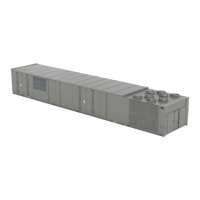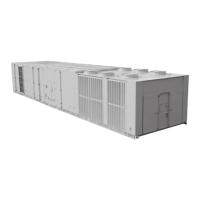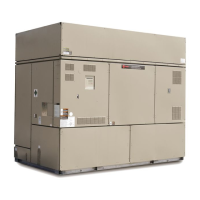RT-SVX24Q-EN
195
Table 73. Air-cooled condenser—refrigerant coil fin data (continued)
Tons
Coil Type
Coil Fin
Config.
Tube Dia. Coil Rows
Fins per foot
Coil Face Area
(sq. ft.)
Tube Type
120
Evaporator
Internally
Finned
1/2
3 168 106.25
Internally Finned
Hi-Cap Evap
Internally
Finned
1/2
6 168 106.25
Internally Finned
Condenser Enhanced 18 mm 2 276 161 Microchannel
130
Evaporator
Internally
Finned
1/2
4 168 106.25
Internally Finned
Hi-Cap Evap
Internally
Finned
1/2
6 168 106.25
Internally Finned
Condenser Enhanced 18 mm 2 276 161 Microchannel
150
Evaporator
Internally
Finned
1/2
6 168 106.25
Internally Finned
Condenser Smooth 18 mm 2 276 161 Microchannel
Fan Belt Adjustment
The supply fan belts and optional exhaust fan belts
must be inspected periodically to assure proper unit
operation.
Replacement is necessary if the belts appear frayed or
worn. Units with dual belts require a matched set of
belts to ensure equal belt length. When removing or
installing new belts, do not stretch them over the
sheaves; instead, loosen the adjustable motor-
mounting base.
Once the new belts are installed, adjust the belt tension
using a Browning or Gates tension gauge (or
equivalent) illustrated in Figure 145, p. 195.
Figure 145. Typical belt tension gauge
Deflection = Belt Span (in.)
64
Deflection = Belt Span (mm)
152
Force Scale
Span Scale
Large
O-Ring
Small
O-Ring
Belt Span
WWAARRNNIINNGG
HHaazzaarrddoouuss VVoollttaaggee ww//CCaappaacciittoorrss!!
FFaaiilluurree ttoo ddiissccoonnnneecctt ppoowweerr aanndd ddiisscchhaarrggee
ccaappaacciittoorrss bbeeffoorree sseerrvviicciinngg ccoouulldd rreessuulltt iinn ddeeaatthh oorr
sseerriioouuss iinnjjuurryy..
DDiissccoonnnneecctt aallll eelleeccttrriicc ppoowweerr,, iinncclluuddiinngg rreemmoottee
ddiissccoonnnneeccttss aanndd ddiisscchhaarrggee aallll mmoottoorr ssttaarrtt//rruunn
ccaappaacciittoorrss bbeeffoorree sseerrvviicciinngg.. FFoollllooww pprrooppeerr
lloocckkoouutt//ttaaggoouutt pprroocceedduurreess ttoo eennssuurree tthhee ppoowweerr
ccaannnnoott bbee iinnaaddvveerrtteennttllyy eenneerrggiizzeedd.. FFoorr vvaarriiaabbllee
ffrreeqquueennccyy ddrriivveess oorr ootthheerr eenneerrggyy ssttoorriinngg
ccoommppoonneennttss pprroovviiddeedd bbyy TTrraannee oorr ootthheerrss,, rreeffeerr ttoo
tthhee aapppprroopprriiaattee mmaannuuffaaccttuurreerr’’ss lliitteerraattuurree ffoorr
aalllloowwaabbllee wwaaiittiinngg ppeerriiooddss ffoorr ddiisscchhaarrggee ooff
ccaappaacciittoorrss.. VVeerriiffyy wwiitthh aa CCAATT IIIIII oorr IIVV vvoollttmmeetteerr
rraatteedd ppeerr NNFFPPAA 7700EE tthhaatt aallll ccaappaacciittoorrss hhaavvee
ddiisscchhaarrggeedd..
FFoorr aaddddiittiioonnaall iinnffoorrmmaattiioonn rreeggaarrddiinngg tthhee ssaaffee
ddiisscchhaarrggee ooff ccaappaacciittoorrss,, sseeee PPRROODD--SSVVBB0066**--EENN..
1. To determine the appropriate belt deflection:
a. Measure the center-to-center distance, in
inches, between the fan sheave and the motor
sheave.
b. Divide the distance measured in Step 1a by 64;
the resulting value represents the amount of
belt deflection for the proper belt tension.
2. Set the large O-ring on the belt tension gauge at the
deflection value determined in Step 1b.
3. Set the small O-ring at zero on the force scale of the
gauge.
4. Place the large end of the gauge on the belt at the
center of the belt span. Depress the gauge plunger
until the large O-ring is even with the of the second
belt or even with a straightedge placed across the
sheaves.
SSeerrvviiccee aanndd MMaaiinntteennaannccee

